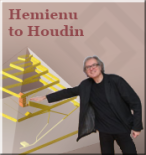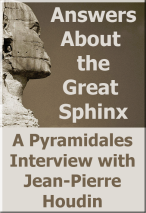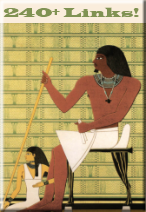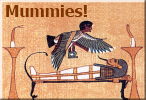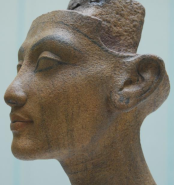 This week’s Digest is dedicated to all things Amarna—the place, the people, and the religion. Discussions, book recommendations, original photography and more.
This week’s Digest is dedicated to all things Amarna—the place, the people, and the religion. Discussions, book recommendations, original photography and more.
Read the rest of this article »
Tags: Akhenaten, Akhetaten, Amarna, Aten, Nefertiti, Tel el Amarna
 Was King Tut a warrior king or “one sick kid”? Even as the Family of Tutankhamun Project was publishing its findings in the Journal of the American Medical Association that the Boy King was a frail young man who needed a cane to walk, Egyptologist W. Raymond Johnson was publishing his evidence that Tut was an active young man who rode chariots into battle.
Was King Tut a warrior king or “one sick kid”? Even as the Family of Tutankhamun Project was publishing its findings in the Journal of the American Medical Association that the Boy King was a frail young man who needed a cane to walk, Egyptologist W. Raymond Johnson was publishing his evidence that Tut was an active young man who rode chariots into battle.
So which is the true Tut? What if both versions are accurate? Could this perfect storm of physical challenges and adventurous behavior have led Tutankhamun to a heroic but early grave?
Read the rest of this article »
Tags: Akhenaten, Albert Zink, Ay II, Battle Narratives, Carsten Pusch, Eighteenth Dynasty, Emily Teeter, Family of Tutankhamun Project, Forensic Mummy Studies, Freiberg-Kohlers Disease, Horemheb, Medical Practices, Oriental Institute Epigraphic Survey, Temple of Luxor, Tutankhamun, W Raymond Johnson
 Meet the mummies of the Family of Tutankhamun Project! If you are looking for a mummy-by-mummy summary of the recent JAMA article, then you are in luck!
Meet the mummies of the Family of Tutankhamun Project! If you are looking for a mummy-by-mummy summary of the recent JAMA article, then you are in luck!
In The Mummies Gallery we will take a look at each of the mummies in both the study and control groups and pull together the familial and pathological data for easy referencing.
Read the rest of this article »
Tags: Akhenaten, Amenhotep III, Ankhesenamun, Beketaten, Eighteenth Dynasty, Family of Tutankhamun Project, Forensic Mummy Studies, Freiberg-Kohlers Disease, Genetic Mapping, Journal of the American Medical Association, KV21A, KV21B, KV35EL, KV35YL, Kiya, Mummy CCG61065, Nebetah, Nefertiti, Queen Ahmose-Nefertari, Queen Thuya, Queen Tiye, Ramesses I, Sitra-In, Thutmose II, Tutankhamun, Yuya
 Was King Tut murdered? Did Akhenaten have both a male and female physiology? Did incest and inbreeding lead the Eighteenth Dynasty down a genetic dead end? Last month the Family of Tutankhamun Project attempted to answer these questions—and more—with the publication of a two-year forensic study of sixteen mummies of the Eighteenth Dynasty.
Was King Tut murdered? Did Akhenaten have both a male and female physiology? Did incest and inbreeding lead the Eighteenth Dynasty down a genetic dead end? Last month the Family of Tutankhamun Project attempted to answer these questions—and more—with the publication of a two-year forensic study of sixteen mummies of the Eighteenth Dynasty.
This article is the first of several in which we will attempt to put the research into layperson’s terms. First we will take a look at the what, who, where, why and how of the study itself.
Read the rest of this article »
Tags: Akhenaten, Albert Zink, Carsten Pusch, Eighteenth Dynasty, Family of Tutankhamun Project, Forensic Mummy Studies, Frank Ruhli, Freiberg-Kohlers Disease, Genetic Mapping, Gino Fornaciari, Journal of the American Medical Association, Paul Gostner, Robert Connolly, Stephen Buckley, Tutankhamun, Yehia Zakaria Gad, Zahi Hawass
 King Tut is known as the Boy King for two reasons. The first is the young age at which he assumed the throne—around eight or nine. The second is that he died at around nineteen, so he never really reached adulthood. Why he died so young is a question that has been with us since his tomb was discovered by Howard Carter in 1922.
King Tut is known as the Boy King for two reasons. The first is the young age at which he assumed the throne—around eight or nine. The second is that he died at around nineteen, so he never really reached adulthood. Why he died so young is a question that has been with us since his tomb was discovered by Howard Carter in 1922.
In 2005 a team of top radiologists conducted a series of CT scans on Tutankhamun’s mummy, and when the results were announced the following year at the annual meeting of the Radiological Society of North America, the results were not 100% conclusive. Most of the team felt they had settled the question of what had caused Tut’s early death, but there were some holdouts.
So when Zahi Hawass announced last August that he was on the verge of announcing the exact cause of Tut’s death, Em Hotep! took notice. So does a new article and video on Dr. Hawass’ website finally put the question to rest?
Read the rest of this article »
Tags: Akhenaten, Amarna, Ashraf Selim, Ay II, Eighteenth Dynasty, Forensic Mummy Studies, Howard Carter, Mummification, Richard Covington, Tutankhamun, Zahi Hawass
Comments Off on King Tut’s Death: Solved, Resolved, or Just Restated?
 Last week Shemsu trudged out into the cold and rain just to bring a local interest story to Em Hotep!’s Kentuckiana readers. Stuffed grape leaves, butter-scotch baklava, and bellydancing. These are just a few of the hazards I braved to bring you this exclusive.
Last week Shemsu trudged out into the cold and rain just to bring a local interest story to Em Hotep!’s Kentuckiana readers. Stuffed grape leaves, butter-scotch baklava, and bellydancing. These are just a few of the hazards I braved to bring you this exclusive.
Pictured to the left, Shemsu’s better half—Sekhmet.
Read the rest of this article »
Tags: Akhenaten, Amarna, Amenhotep III, Andrea Deagon, Apis Bull, Bellydancing, Egyptian Art, Eighteenth Dynasty, Ghawazee, Karnak Temple, Louisville, Luxor, Nebamun, Roman Period, Temple of Amun at Karnak, Tomb Art
Posted by: Keith Payne
in
Read the rest of this article »
Tags: Ahmose I, Akhenaten, Amarna, Amenhotep I, Amenhotep II, Amenhotep III, Amenhotep IV, Ay II, Eighteenth Dynasty, Horemheb, Memphis, New Kingdom Period, Priesthood of Amun, Ramesses-I, Smenkhkare, Thutmose II, Thutmose III, Thutmose IV, ThutmoseI, Tutankhamun
 Was King Tut a warrior king or “one sick kid”? Even as the Family of Tutankhamun Project was publishing its findings in the Journal of the American Medical Association that the Boy King was a frail young man who needed a cane to walk, Egyptologist W. Raymond Johnson was publishing his evidence that Tut was an active young man who rode chariots into battle.
Was King Tut a warrior king or “one sick kid”? Even as the Family of Tutankhamun Project was publishing its findings in the Journal of the American Medical Association that the Boy King was a frail young man who needed a cane to walk, Egyptologist W. Raymond Johnson was publishing his evidence that Tut was an active young man who rode chariots into battle. This week’s Digest is dedicated to all things Amarna—the place, the people, and the religion. Discussions, book recommendations, original photography and more.
This week’s Digest is dedicated to all things Amarna—the place, the people, and the religion. Discussions, book recommendations, original photography and more.

 King Tut is known as the Boy King for two reasons. The first is the young age at which he assumed the throne—around eight or nine. The second is that he died at around nineteen, so he never really reached adulthood. Why he died so young is a question that has been with us since his tomb was discovered by Howard Carter in 1922.
King Tut is known as the Boy King for two reasons. The first is the young age at which he assumed the throne—around eight or nine. The second is that he died at around nineteen, so he never really reached adulthood. Why he died so young is a question that has been with us since his tomb was discovered by Howard Carter in 1922. Last week Shemsu trudged out into the cold and rain just to bring a local interest story to Em Hotep!’s Kentuckiana readers. Stuffed grape leaves, butter-scotch baklava, and bellydancing. These are just a few of the hazards I braved to bring you this exclusive.
Last week Shemsu trudged out into the cold and rain just to bring a local interest story to Em Hotep!’s Kentuckiana readers. Stuffed grape leaves, butter-scotch baklava, and bellydancing. These are just a few of the hazards I braved to bring you this exclusive.